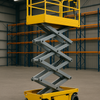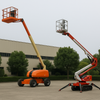How to Choose the Right Scissor Lift for Your Warehouse

I talk with warehouse managers every week. Some run small e-commerce stores. Some are in auto parts. Their first question is always the same:
“Which scissor lift should I buy for my warehouse?”
It sounds like an easy question. It isn’t. Different racks, floors, aisles, and jobs make the choice very different. In this guide I’ll share how I help buyers pick a lift that truly fits. No big words. Just clear steps and real tips from daily work.
1) Quick idea: what a scissor lift does (and doesn’t)
A scissor lift goes straight up and down. The “X” arms push the platform up. It is stable, has guardrails, and one person can drive it. It is safer and faster than a ladder.
It is not a crane. It is not for moving pallets across long distance. It is for bringing a person (and tools or a small load) to a certain height, do the job, and come down.
Typical warehouse jobs:
-
Change light tubes and install cable trays
-
Pick items from high shelves
-
Repair sprinklers and sensors
-
Clean, paint, hang signs
If that sounds like your work, a scissor lift makes sense.
2) Know the three common types (warehouse view)
A. Electric self-propelled (most popular indoors)
-
Battery drive, low noise, no exhaust
-
One person can drive and lift from the platform
-
Best for daily use inside the warehouse
Good because: clean, easy to learn, fast to move between aisles
Watch for: battery care; charge every day, avoid deep discharge
B. Manual-push / semi-electric
-
You push it to the spot by hand, then lift electrically or by hand
-
Price is friendly
Good because: simple, low budget, light weight
Watch for: slow when jobs are many or far apart
C. Rough-terrain / diesel (mostly outdoor)
-
Big tires, high ground clearance
-
Works on yards and construction areas
Good because: handles uneven ground
Watch for: noise, emission; not the first choice for indoor warehouse
If your warehouse is standard, 90% of the time you will choose electric self-propelled or manual-push.
3) Five numbers you must confirm
When I receive an enquiry, I always ask five numbers. If you have them, choosing becomes simple.
-
Top rack height (or work point height)
Measure from floor to the highest point you need to reach.
Rule of thumb: working height = platform height + 2 m (arm reach + headroom).Example: your top sprinkler is 9 m high. You need platform height around 7 m (9 – 2). Choose a lift with working height 9 m–10 m.
-
Aisle width
The lift must pass without hitting the racks.-
Narrow aisles (≤1.2 m): pick a machine width ≤1.0 m if possible.
-
Normal aisles (1.4–1.8 m): 1.15–1.2 m machines are fine.
-
-
Floor strength
Ask your facility team: floor point load and overall load.
Many modern floors handle 3–5 t easily, but better to check. If in doubt, choose lighter models or spread the load with pads. -
Platform capacity
Think about people + tools + parts.-
Maintenance: 200–320 kg is okay
-
Heavy fixtures: consider 450–700 kg
-
-
Daily travel distance
If your jobs are far apart, self-propelled saves time. If most work is in one corner, manual-push is enough.
Write these numbers on paper. You already did half of the selection work.
4) Choosing height without over-buying
Many buyers overspend on height. Here is a simple way:
-
If your highest work point is 6–7 m, choose 8–9 m working height
-
If 8–10 m, choose 10–12 m working height
-
If 12–14 m, choose 14–16 m working height
Leave a small margin so workers don’t stretch their body at top. Too much height, however, makes the machine bigger and heavier, which is not good for tight aisles.
5) Size matters: fit your aisles and doors
Two sizes count most: machine width and turning radius.
-
For aisles around 1.2 m, target machine width 0.8–1.0 m
-
For aisles 1.5 m, width 1.15–1.2 m is okay
-
Check door height too. Some lifts with rails up can be taller than 2.1 m. Many have foldable rails. Ask for that if your doors are low.
Small tip: ask the supplier for a 2D footprint drawing (top view). Print it and compare with your aisle drawing. It avoids mistakes.
6) Capacity and platform space
Workers like a little extra room. A platform around 2.2 m × 1.0 m feels comfortable for two people. If your items are long (like ducts), ask for platform extension. Many lifts have a slide-out deck (0.9–1.0 m). It helps more than you think.
Capacity guideline:
-
Two persons + tools: 320 kg works well
-
Larger maintenance teams or heavy parts: 450 kg or above
Don’t forget: higher capacity means heavier machine. Balance the need with your floor and aisle limits.
7) Self-propelled vs manual-push (realistic view)
| Question | Self-Propelled | Manual-Push |
|---|---|---|
| Daily jobs, spread out? | Saves 30–40% time in my clients’ cases | Workers get tired pushing |
| Budget tight? | Higher price | Lower price |
| Training | 1–2 hours basic training | Very quick |
| Best use case | Medium/large warehouse, frequent tasks | Small site, occasional jobs |
To be honest, where there is daily work at different locations, self-propelled pays for itself in a year just by saving man-hours.
8) Battery, charging, and shift planning
For most warehouses I recommend maintenance-free gel or lithium batteries. Both are clean. If you run two shifts, plan a spare battery pack or fast charging zone.
Simple charging rules that work:
-
Charge every day after work
-
Keep battery above 30%; avoid deep discharge
-
Once a month, do a full charge equalization (follow the charger manual)
Good batteries are cheaper than downtime.
9) Safety features you should insist on
Do not compromise on safety. At minimum, make sure the lift includes:
-
Emergency stop (platform + ground)
-
Emergency lowering system
-
Tilt sensor with alarm and cut-off
-
Overload protection
-
Non-slip platform and toe boards
-
Automatic pothole protection (for indoor models)
-
Travel speed limit when platform is up
-
Key switch to control access
Also ask for operator training video and a simple checklist you can print and post near the charger.
10) A small story from a client (real case)
Last spring, a client in the UAE called me. His warehouse is 10 m high, aisle 1.3 m. They changed to LED lights and needed weekly maintenance. Their old manual lift was okay but too slow.
We looked at two options:
-
Option A: 8 m manual-push, 230 kg, very cheap
-
Option B: 10 m self-propelled, 320 kg, narrow chassis 1.0 m, with foldable rails
He chose Option B. After three months he wrote back: workers finished jobs 30% faster; no blocked aisles; batteries held a full day with regular charging. Simple choice, but the right one.
11) Cost thinking: not only the price tag
When buyers compare models, I ask them to write four lines:
-
Purchase price
-
Annual maintenance (batteries, oil, wheels)
-
Downtime cost (if the lift is down, how many jobs stop?)
-
Resale value after 3–5 years
A slightly higher-priced machine with better battery and service can be cheaper in three years. Numbers make it clear.
12) Maintenance basics (the 10-minute habit)
You don’t need an engineer every day. A 10-minute habit keeps the lift healthy:
-
Walk-around check before use (rails, bolts, hoses)
-
Test emergency stop and tilt alarm
-
Keep platform clean and dry
-
After shift: park at the charger, switch off, plug in
-
Record small issues; fix them on Friday, not when they become big
If you prefer a checklist, here’s a short one you can paste on the wall:
Daily Quick Check
-
Wheels and scissor arms – no cracks, no loose bolts
-
Guardrails and gates – lock works, no bend
-
Controls – up/down and drive respond well
-
Alarms – tilt and overload buzzer can be heard
-
Battery – above 30%, charger light normal
That’s it. Five points, two minutes.
13) Common mistakes (you can easily avoid)
-
Buying more height than needed. Bigger is heavier; aisles suffer.
-
Ignoring floor load data. Ask once, save trouble later.
-
No charging plan. Then the lift is always “almost dead” in the afternoon.
-
Not training new staff. A 30-minute session saves a forklift-rack accident.
-
Skipping spare parts list. Keep basic spares: wheels, charger fuse, joystick cover.
14) Simple selection flow (use it with your team)
-
Write down work height, aisle width, floor data, capacity, daily travel distance.
-
If jobs are spread out → self-propelled; if not → manual-push.
-
Match height to working height table with small safety margin.
-
Check machine width vs aisle and door height vs rail height.
-
Confirm battery plan (charger location, daily routine).
-
Tick the safety features list.
-
Ask for drawings + spare parts list + training video.
-
Place order with clear delivery and warranty terms.
This is the same flow I use for quotes. It keeps everyone on the same page.
15) A few models that usually fit (by scenario)
-
Small webshop warehouse, 6–8 m ceiling, narrow aisles
→ 8–9 m narrow electric self-propelled, width ≤1.0 m, 230–320 kg -
Spare-parts warehouse, 10–12 m ceiling, many daily tasks
→ 10–12 m self-propelled, platform 2.2 × 1.0 m with extension, 320 kg -
Maintenance team in a mixed site (indoor + yard)
→ 10–12 m self-propelled electric for indoors + one rough-terrain unit for outdoor days -
Occasional use, fixed work zone, tight budget
→ 6–8 m manual-push or semi-electric, 200–230 kg
(Replace with your exact numbers when you publish; the pattern stays the same.)
16) Final words
There is no “best” scissor lift for everyone. There is only the right lift for your warehouse. Measure your height, check your aisles, think about how often you move, and plan charging. Do these steps and you won’t make a wrong choice.
If you need a spec sheet or a quick drawing to check fit with your racks, tell me your numbers. I can prepare it the same day. It will make the decision easy for your team.
Stay safe and keep the work simple.



